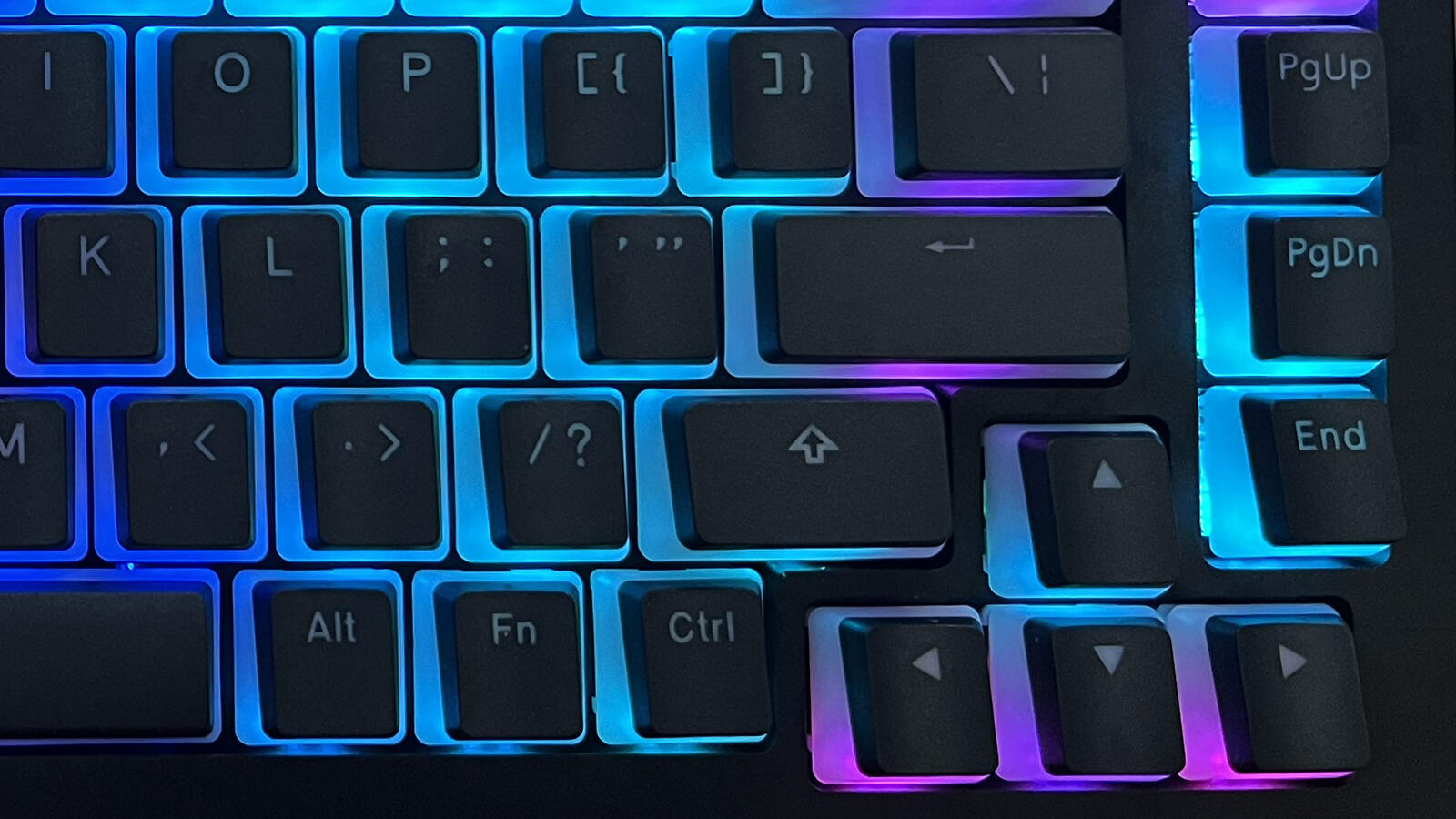While I always do everything in my power to go into a review with a neutral outlook and clean slate of expectations, I felt I should still mention this was the mindset I’d historically held when the Glorious Aura Mechanical Keycaps arrived for review. These are Glorious’ own take on the pudding genre (named for its resemblance to multi-layered pudding cups when viewed from the side) and, to get right to the point, the best pudding caps I’ve ever used. Read on to find out why.
Feel and sound
The first thing that surprised me about these caps was that they were made with thick, doubleshot PBT plastic. This means that there are actually two discrete layers of plastic (one translucent and one in either black, white, or pink, depending on your chosen colorway) that fit together so tightly there’s no detectable gap. I did try to detect one, for the record, but no fingernail nor fingertip could sense it. Being used to cheap, thin pudding caps made of one-layer translucent plastic, this was my first tip. It was time to sit down and take notice. Also: Mechanical keyboards: A comprehensive guide One of the other significant pudding cap drawbacks has historically been their tendency to let far too much light through. Even boards that had relatively tame backlighting became veritable beacons if you slapped a set of pudding caps on them. However, Glorious’ Aura caps and their thicker PBT plastic provide far better lighting than most competitors. This doesn’t serve to block the light to the point of making it drab. It just pleasantly diffuses it, giving each key a soft but still very saturated glow that looks unusually high-end. The feel of the caps is surprisingly plush as well, especially given the $30 asking price for a 145-key set that should fill out nearly any board, with the possible exception of truly exotic layouts. As the often less-than-proud owner of several keycaps sets that cost almost 10 times that much, I can say the PBT feels about as solid as any I’ve used. I will note that it’s one of the smoothest PBT caps I’ve ever tested. If you prefer PBT for that almost sandpaper-like roughness it can have, these aren’t for you. However, if you like it for the thick feeling it can lend to keys and the sound-deadening properties it can provide to help reduce spring whine and other unpleasant pings, those are all present here.
Fit and finish
Overall, I found the finish much better than its price point would suggest. There were no excessive rough spots on the bottom sides, nor any prominent sprue marks from the casting process. I’ll also reiterate that the doubleshot layers fit pretty much perfectly. The set wasn’t entirely without its flaws, however. There was one issue where the spacebar wanted to stick on one board (Glorious’ own GMMK Pro) but was fine on all others I tested (like the Drop ALT). If you’re wondering, I did double-check that it was the correct size, and it was. It seemed to be a slight tolerance issue with the spacing of the space bar stabilizers. This issue is something that could likely be solved with 5 minutes and some sandpaper applied to the stems, but it’s not something most end users would be too happy to have to deal with. Out of the 5 boards that I tested the keycaps on, only the GMMK Pro showed signs of sticking. I can’t be sure if you’ll run into this, and I can’t say for sure your specific space bar won’t be fine everywhere, but it’s worth noting. Also: 5 best mechanical keyboards: From mini to macros My only other gripe applies to the legends. That same thick, diffusing PBT that I praised for giving the sides of the keycaps a soft glow dampens the lighting of the legends a little too much. I had to up the brightness on most of my testing boards to near their maximum in order to make out the backlit legends, even in somewhat dim lighting. It’s not a huge deal most of the time, especially if you’re an experienced touch-typist, but it could be problematic during those moments when you’re seeking an uncommonly used key on a bright day. They’re legible, just not as clear as I’d like.
Bottom line
I already spoiled the ending, but I’ll say again these are the best pudding caps I’ve ever used. Aside from the few minor fit and finish issues I mentioned, I would definitely consider using them myself in a board that I wanted to ascribe to the RGB aesthetic that would show them off to their best effect. While I’ve paid for several stupidly expensive keycap sets, I by no means think they’re for everyone, nor do I think they’re always the best. For example, I still use a $50 set from Matrix Keyboards on one of my daily drivers, and I’m still quite pleased with it. I’ve always been particularly chuffed to remember I paid only $50 for it…and then Glorious’ Aura keycaps come along at $35 and makes me feel like I overpaid.
Alternatives to consider
HyperX’s pudding keycaps are very similar on paper. They’re also doubleshot PBT and also sell for a bargain price of $25. However, they’re a bit more translucent and their font is definitely more “gamery,” but that could be a good thing for the right user. If you like the idea of cheap ($30) doubleshot PBT but don’t want pudding keycaps, Razer makes a shine-through line of caps that use the same materials. These caps, which will fit on any Cherry MX-compatible board and come in black, white, green, and pink colorways. One of my personal favorite budget keycap companies, Matrix Keyboards, makes their own sets of pudding caps. This unique keyboard sets up the color by using the company’s Peacock colorway on its translucent shells.
